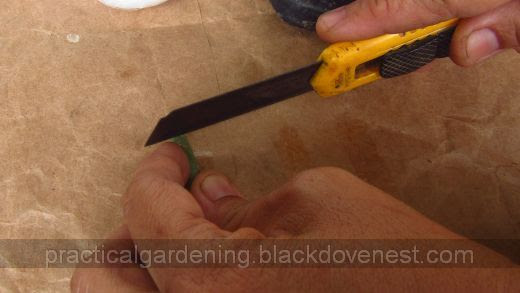Unlike the technique in the previous article, this method utilizes only one node on the stem of a desired adenium plant for a scion.
Because the resulting scion is short (only one node), it is more stable when seated on the stock. The increased surface contact between scion and stock results in a better success rate.
The adenium variety I'm grafting is the beautiful "Adenium Triple Santa" as shown below.
I will be making scions out of its stem to propagate this particular variety. The stock I'll be using are coming from ordinary single-petaled pink varieties. These common varieties are very hardy and have vigorous growth.
Step-by-Step Guide to Adenium Flat Grafting - One Node Technique
Materials and Tools
Some of the materials and tools used for this tutorial are shown below. Clockwise from top: Isopropyl alcohol, clean rag, grafting tape and cutter or sharp knife.
- Isopropyl Alcohol. For sanitizing cutting tools, e.g., cutter or knife.
- Grafting Tape. For wrapping and tying the scion together with the stock. In the absence of grafting tape, you may use a narrow piece of polyethelene sheet that's stretchable, e.g., cling or stretch wrap.
- Tissues. For wiping dry the cut wounds on the scion and stock.
- Clean Rag. For cleaning the cutter with alcohol.
- Cutter or Sharp Knife. For cutting the scion and stock.
- Scissors. For cutting grafting tape.
Procedure
- Pour a bit of alcohol on a clean rag. Wipe the wet rag on both sides of the blade of the cutter. You may do this by laying the wet rag on a table and then sliding the cutter blade across as shown below.
- With the sanitized cutter, cut the stem of the adenium that you would like to propagate. This stem will be the source for the scions. The scion stem below has about eight nodes or scions.
- After cutting, remove the leaves of the stem except for the top most part. The top part of the stem which thins out may be used for wedge or V-graft later.
- Gently tap or rest the wound of the scion stem on some tissues so the oozing sap may be absorbed. The purpose is to keep the wound still fresh but just a bit dry and not oozing with sap.
- With a rag wet with alcohol, wipe the de-leafed length of the scion stem to clean it of debris, tiny insects or anything that may cause disease.
- Bring the scion stem near the stock and compare their thicknesses. Identify a point on the stock stem that is ideal for cutting. The cutting point should have thickness roughly equal or more than the thickness of the scion stem.
The stock cut diameter should not be smaller than the scion cut diameter.
- Make a horizontal cut on the stock stem keeping it as flat as possible. Remember to wipe the cutter with alcohol before cutting any plant parts.
- Cut off any other branches or forming buds on the stock since you're after the characteristics of the scion's adenium variety to be grafted. Also, by removing these branches, the plant's energy resources may be channeled instead to the development of the scion's buds.
- Dab dry tissues on the stock wound to absorb the sap.
- Wipe the cutter again with the rag wet with alcohol. Cut one scion from the scion stem. Preferably keep the scion as short as possible with only one node in the scion - unless there is another node on the opposite side. The scion's length may be anywhere from 1/2" to 3/4".
Keep the cut as flat as possible. This will allow maximum surface area contact with the stock.
(See Part 2 for the continuation of this article)











Go ahead, post your comment below!
Love your method I am going to try a graft on one of my babies 6inches high cautex seems to be big enough to try
Tnx! Go for it.